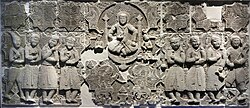
Back السلالة الطولونية Arabic Tulunoğulları Azerbaijani তুলুনি রাজবংশ Bengali/Bangla Tulúnida Catalan Tulunider Danish Tuluniden German Τουλουνίδες Greek Tulunidoj Esperanto Tuluníes Spanish Tulundarrak Basque
Tulunid Emirate الإِمَارَةُ الطُّولُونِيَّة (ar) | |||||||||||
|---|---|---|---|---|---|---|---|---|---|---|---|
| 868 | |||||||||||
![Tulunid Emirate in 893.[1]](http://upload.wikimedia.org/wikipedia/commons/thumb/d/d9/Tulunids_893.png/330px-Tulunids_893.png) Tulunid Emirate in 893.[1] | |||||||||||
 Map showing the borders of the Tulunid Emirate within the contemporary political boundaries of the Arab World | |||||||||||
| Status | Vassal of the Abbasid Caliphate | ||||||||||
| Capital | Al-Qata'i | ||||||||||
| Official languages | Arabic (Official Language) Turkish (Military Language) | ||||||||||
| Recognised regional languages | Syriac language, Coptic language, Biblical Hebrew | ||||||||||
| Common languages | Arabic, Egyptian, Greek, Syriac, Old Nubian (Public), Turkic (Army) | ||||||||||
| Religion | Sunni Islam (predominant, official religion), Twelver Shi'ism (Minority), Christianity (Largest Minority), Judaism (Minority) | ||||||||||
| Government |
| ||||||||||
| Emir | |||||||||||
• 868–884 (first) | Aḥmad ibn Ṭūlūn | ||||||||||
• 904–905 (last) | Shayban ibn Ahmad ibn Tulun | ||||||||||
| History | |||||||||||
• Established | 868 | ||||||||||
• Abbasid reconquest | 905 | ||||||||||
| Currency | Dinar | ||||||||||
| |||||||||||
| Today part of |
| ||||||||||
| History of the Turkic peoples pre–14th century |
|---|
 |
The Tulunid State, also known as the Tulunid Emirate or The State of Banu Tulun, and popularly referred to as the Tulunids (Arabic: الطولونيون) was a Mamluk dynasty of Turkic origin[2] who was the first independent dynasty to rule Egypt, as well as much of Syria, since the Ptolemaic dynasty.[3] They were independent from 868, when they broke away from the central authority of the Abbasid Caliphate, to 905, when the Abbasids restored the Tulunid domains to their control.
Tulunid State emerged during a period marked by the growing power of the Turkic within the Abbasid Caliphate. This was a time when the Turkish guard exerted control over the empire's affairs, and when ethnic Shu'ubiyya and separatist tendencies began to emerge among the various peoples and governors of the vast Abbasid territories. The establishment of the Tulunid State was one of the inevitable outcomes of this growing sentiment. In the late 9th century, internal conflict amongst the Abbasids made control of the outlying areas of the empire increasingly tenuous, and in 868 the Turkic officer Ahmad ibn Tulun established himself as an independent governor of Egypt. He subsequently achieved nominal autonomy from the central Abbasid government. During his reign (868–884) and those of his successors, the Tulunid domains were expanded to include Jordan Rift Valley, as well as Hejaz, Cyprus and Crete. Ahmad was succeeded by his son Khumarawayh, whose military and diplomatic achievements made him a major player in the Middle Eastern political stage. The Abbasids affirmed their recognition of the Tulunids as legitimate rulers, and the dynasty's status as vassals to the caliphate. After Khumarawayh's death, his successor emirs were ineffectual rulers, allowing their Turkic and black slave-soldiers to run the affairs of the state. In 905, the Tulunids were unable to resist an invasion by the Abbasid troops, who restored direct caliphal rule in Syria and Egypt.[4][5]
The Tulunid period was marked by economic and administrative reforms alongside cultural ones. Ahmad ibn Tulun changed the taxation system and aligned himself with the merchant community. He also established the Tulunid army. The capital was moved from Fustat to al-Qata'i, where the celebrated mosque of Ibn Tulun was constructed.
- ^ Freeman-Grenville, G. S. P. (Greville Stewart Parker) (1993). Historical atlas of the Middle East. New York : Simon & Schuster. p. 35. ISBN 978-0-13-390915-9.
- ^ Anjum 2007, p. 233.
- ^ Holt, Peter Malcolm (2004). The Crusader States and Their Neighbours, 1098-1291. Pearson Longman. p. 6. ISBN 978-0-582-36931-3.
The two gubernatorial dynasties in Egypt which have already been mentioned, the Tulunids and the Ikhshidids, were both of Mamluk origin.
- ^ "Tulunid Dynasty." Encyclopædia Britannica
- ^ "Ṭūlūnids," Encyclopaedia of Islam
© MMXXIII Rich X Search. We shall prevail. All rights reserved. Rich X Search